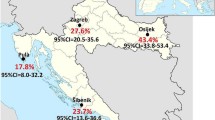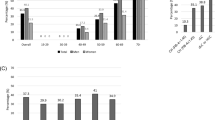Summary
4000 sera were tested for antibodies against hepatitis C virus (HCV) by means of an ELISA using the C100-3 antigen. 38.9% of patients with non-A, non-B hepatitis following blood transfusion (n=108) had HCV antibodies. Among patients with chronic liver damage of unknown origin (n=316) 30.4% were anti-HCV positive, and in 2,506 patients with transitional or chronic elevation of transaminases 14.8% showed HCV antibodies. Haemophiliacs (n=26) with 65.4% anti-HCV positives and drug addicts (n=46) with 56.5% anti-HCV positives had the highest prevalence among high risk groups. Addicts dying from drug abuse (n=216) and HIV 1 positives (n=127) were anti-HCV positive in 37.5% and 26.0%, respectively. Patients on haemodialysis (n=331) had antibodies against HCV in 12.4%. Health care workers (n=217) appear to be at a comparably low risk with only 2.8% anti-HCV positives. Up to now we could not find a single case of intrafamilial spread of HCV in 46 examined cases. We suggest that HCV infectivity of contaminated body fluids and blood is lower than that of hepatitis B virus or human immunodeficiency virus type 1 carriers. In suspected non-A, non-B hepatitis negative test results should be confirmed in a second sample because it may take three to six months after infection before HCV antibodies occur. However, about 10% of chronic HCV infections are not detectable with the presently available test. This may change when new tests become available using HCV specific antigens other than C100-3.
Zusammenfassung
Wir untersuchten bislang 4000 Seren auf das Vorliegen von Antikörpern gegen das Hepatitis-C-Virus (HCV). In unserer Studie hatten Patienten mit einer Non-A, Non-B Hepatitis nach Bluttransfusion (n=108) in 38,9% HCV-Antikörper. Patienten mit chronischen Lebererkrankungen (n=316) zeigten diese Antikörper in 30,4%, und Patienten mit vorübergehenden oder anhaltenden Transaminasenerhöhungen (n=2506) waren in 14,8% anti-HCV positiv. Unter den Risikogruppen mit parenteralem Blutkontakt waren Hämophiliepatienten (n=26) mit 65,4% am häufigsten HCV-Antikörper-positiv, gefolgt von Drogenabhängigen (n=46; 56,5%) und Drogentoten (n=216; 37,5%). HIV-infizierte Patienten (n=127) zeigten HCV-Antikörper in 26,0%, und Hämodialysepatienten (n=331) waren in 12,4% positiv. Die Gefährdung für medizinisches Personal ist offenbar relativ gering: nur 2,8% der untersuchten 217 Mitarbeiter mit parenteralem Infektionsrisiko hatten HCV-Antikörper. Bisher konnten wir noch in keinem Fall eine HCV- Übertragung durch Nadelstich-oder Skalpellverletzung belegen; auch familiäre Kontakte führten bei den von uns untersuchten 46 Angehörigen HCV-positiver Patienten bislang nicht zur Infektion. Die Infektiösität HCV-positiver Patienten ist möglicherweise geringer als die von HBV- oder HIV-infizierten Patienten. Wenn der Verdacht auf eine Hepatitis Non-A, Non-B vorliegt, so sollte ein negatives Testergebnis jedoch unbedingt in einer weiteren Serumprobe bestätigt werden, da es nach erfolgter Infektion drei bis sechs Monate dauern kann, bis die Serokonversion auftritt. Ein Teil der HCV- Infektionen kann mit dem derzeit zur Verfügung stehenden Test nicht erkannt werden, bei der chronischen HCV-Infektion sind dies ca. 10% der Fälle. Vielleicht wird deren Nachweis erst dann gelingen, wenn es weitere Teste gibt, die Antikörper gegen andere antigene Epitope des Hepatitis-C-Virus nachweisen können.
Similar content being viewed by others
References
Choo, Q.-L., Kuo, G., Weiner, A. J., Overby, L. R., Bradley, D. W., Houghton, M. Isolation of a cDNA clone derived from a blood-borne non-A, non-B viral hepatitis genome. Science 244 (1989) 359–362.
Kuo, G., Choo, Q.-L., Alter, H. J., Gitnick, G. L., Redeker, A. G., Purcell, R. H., Miyamura, T., Dienstag, J. L., Alter, M. J., Stevens, C. E., Tegtmeier, G. E., Bonino, F., Colombo, M., Lee, W.-S., Kuo, C., Berger, K., Shuster, J. R., Overby, L. R., Bradley, D. W., Houghton, M. An assay for circulating antibodies to a major etiologic virus of human non-A, non-B hepatitis. Science 244 (1989) 362–364.
Laufs, R., Heisig, V., Karch, H., v. Laer, M., Sandkamp, O., Ermer, M. Zusammenfassung des derzeitigen Kentnisstandes über AIDS: Erreger, Epidemiology, Schutzmaßnahmen und Testindikationen. Hamburger Ärzteblatt 41 (1987) 259–269.
Esteban, J. I., Viladomiu, L., Gonzalez, A., Roget, M., Genesca, J., Esteban, R., Lopez-Talavera, J. C., Vargas, V., Buti, M., Guardia, J., Houghton, M., Choo, Q.-L., Kuo, G. Hepatitis C virus antibodies among risk groups in Spain. Lancet ii (1989) 294–297.
Schlipköter, U., Roggendorf, M., Ernst, G., Rasshofer, R., Deinhardt, F., Weise, A., Gladziwa, K., Luz, N. Hepatitis C virus antibodies in haemodialysis patients. Lancet i (1990) 1409.
Tamura, I., Kobayashi, Y., Koda, T., Ichimura, H., Kurimura, O., Takasugi, T., Kurimura, T. Hepatitis C virus antibodies in haemodialysis patients. Lancet i (1990) 1409.
Yamaguchi, K., Nishimura, Y., Fukuoka, N., Machida, J., Ueda, S., Kusumoto, Y., Futami, G., Ishii, T., Takatsuki, K. Hepatitis C virus antibodies in haemodialysis patients. Lancet i (1990) 1409–1410.
Makris, M., Preston, F. E., Triger, D. R., Underwood, J. C. E., Choo, Q.-L., Kuo, G., Houghton, M. Hepatitis C antibody and chronic liver disease in haemophilia. Lancet i (1990) 1117–1119.
Kühnl, P., Seidl, S., Stangel, W., Beyer, J., Sibrowski, W., Flik, J. Antibody to hepatitis C virus in German blood donors. Lancet ii (1989) 324–325.
Ideo, G., Bellati, G., Pedraglio, E., Bottelli, R., Dongelli, T., Putigniano, G. Intrafamilial transmission of hepatitis C virus. Lancet i (1990) 353.
Roggendorf, M. Hepatitis-C-Virus. Dtsch. Med. Wochenschr. 115 (1990) 352–354.
Laufs, R., Polywka, S., Krüger, W., Nolte, H., Friedrich, K., Henning, H. Hepatitis-C-Virus Antikörper bei Hepatitis-Patienten und Risikogruppen. Deutsches Ärzteblatt 86 (1989) 2643–2644.
Author information
Authors and Affiliations
Rights and permissions
About this article
Cite this article
Polywka, S., Laufs, R. Hepatitis C virus antibodies among different groups at risk and patients with suspected non-A, non-B hepatitis. Infection 19, 81–84 (1991). https://doi.org/10.1007/BF01645572
Received:
Accepted:
Issue Date:
DOI: https://doi.org/10.1007/BF01645572




